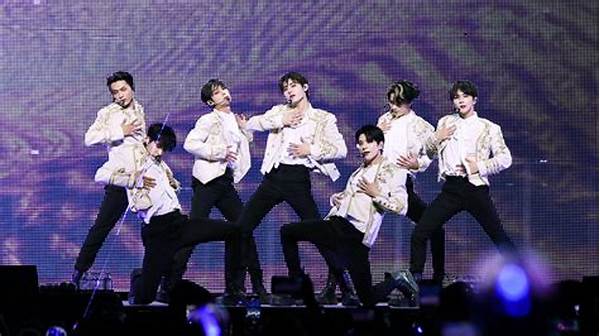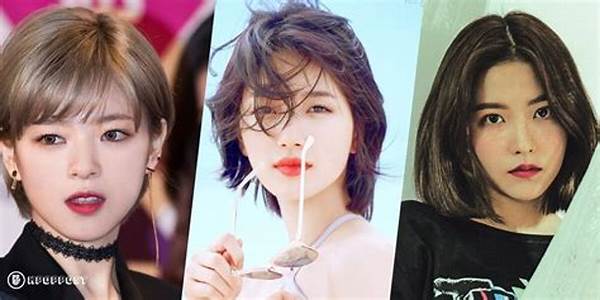Hey there, K-pop fans and fashion lovers! Today, we’re about to dive into a fascinating journey through the evolution of K-pop gender fashion. K-pop has always been at the forefront of fashion innovation, breaking boundaries and defying norms, and gender fashion is no exception. Over the years, we’ve seen our favorite idols revolutionize what it means to dress without constraints, blending traditional male and female aesthetics to create something entirely unique. So, buckle up as we explore this vibrant world where style knows no gender boundaries!
Read Now : Wallet-friendly K-pop Concert Outfits
Breaking Stereotypes: The Rise of Androgynous Fashion
In the early days of K-pop, fashion choices were often confined to traditional gender norms. Female idols donned cute, girly outfits, while male idols stuck to sleek and masculine looks. However, with the evolution of K-pop gender fashion, the androgynous style has become a mainstay. The rise in popularity of groups like SHINee, BIGBANG, and more recently, artists like BTS and Amber Liu, marks this change. They boldly challenged the norms, stepping out in styles that blur the lines between masculinity and femininity—think skinny jeans paired with bold makeup or skirts layered with leather jackets. This evolution signifies more than just a fashion shift; it symbolizes a wider acceptance of gender diversity in K-pop, celebrating the complexity of modern identity.
The evolution of K-pop gender fashion was also greatly influenced by global fashion trends and the inclusive environments of countries like Korea. These influences encourage more artists to experiment with their style. G-Dragon is a particularly notable figure, known for his avant-garde fashion sense. He often experimented with styles that merged and transcended gender, making headlines around the world. His fearless approach inspired many idols and fans to embrace fluidity in fashion, celebrating individuality and creativity. It showed that fashion is not just about clothes, but about expressing oneself without confines.
K-pop idols and their flashy gender-neutral fashion choices have made it acceptable, and even trendy, to embrace non-traditional styling. With every new song and dance, they continue to push boundaries, redefining gender fashion and showing the world that style has no limits. The evolution of K-pop gender fashion is an exciting journey that speaks to the power of music and cultural influence, inspiring young people everywhere to express who they truly are without fear of judgment.
Iconic Moments in K-Pop Gender Fashion
In 2013, G-Dragon wowed everyone at a fashion show wearing a skirt. His bold choice became a pivotal moment in the evolution of K-pop gender fashion, proving that style isn’t confined by gender.
Amber Liu of f(x), with her tomboyish style and charisma, became a symbol of the evolution of K-pop gender fashion, challenging traditional female stereotypes.
When BTS rocked the world with their single “Boy with Luv,” their colorful, gender-fluid outfits showed how far the evolution of K-pop gender fashion had come, setting new trends globally.
Girl group MAMAMOO often sported suits and ties on stage, showcasing the evolution of K-pop gender fashion and empowering women to embrace both masculine and feminine styles.
Taemin, a member of SHINee and a solo artist, exemplified the evolution of K-pop gender fashion by constantly incorporating feminine elements into his appearances, inspiring an entire generation of fans.
The Influence of Western Culture on K-Pop Fashion
Western pop culture has made a significant impact on the evolution of K-pop gender fashion. Global fashion icons like David Bowie and Prince blurred gender lines in their music and style. These influences made their way to Korea, encouraging K-pop idols to embrace similar aesthetics in their music videos, performances, and public appearances. The open-mindedness of Western fashion principles, like androgyny and gender-fluid clothing, meshed well with Korea’s rapidly evolving music scene. As a result, many K-pop idols now choose to incorporate elements inspired by these trailblazers in their looks, pushing the evolution of K-pop gender fashion even further.
Read Now : Ateez Concert Ensemble Creation
Additionally, international collaborations with fashion designers from around the world have played a crucial role in this transformation. These collaborations often result in iconic looks that blend the best of Eastern and Western fashion, highlighting the evolution of K-pop gender fashion. When Jackson Wang features in a global fashion campaign or when BLACKPINK wears daring, gender-neutral styles, they bridge cultural gaps and contribute to the global dialogue of gender expression. The evolution of K-pop gender fashion becomes more significant as idols continue to reach international audiences, celebrating diversity and the freedom to express oneself through clothing.
Cultural Impacts on Fashion
The evolution of K-pop gender fashion is also deeply rooted in Korean culture and values. Korea has a rich history of intricate traditional attire such as hanbok, which is gendered but frequently incorporates elements of elegance and boldness for all genders. The modern K-pop scene often taps into this cultural legacy while reinterpreting it for contemporary audiences. As K-pop gained international fame, so did these nuanced takes on fashion, encouraging artists and fans alike to break away from strictly Western notions of gender-specific clothing.
The evolution of K-pop gender fashion also reflects generational shifts in attitudes toward gender roles. Younger fans are more open-minded and value authenticity, characteristics that K-pop idols embody by defying traditional gender norms. As these artists showcase a variety of styles and personas, they inspire their audience to embrace themselves and defy the societal boxes often imposed on fashion. It also speaks volumes about how K-pop is not just about the music—it’s a cultural movement altering perceptions worldwide.
Future Trends in K-Pop Gender Fashion
Looking to the future, the evolution of K-pop gender fashion seems set to continue its progressive path. As the lines between male and female fashion blur even further, we can expect a rise in unisex collections and more freedom in how idols express themselves. K-pop agencies, recognizing the appeal of such diverse styling, will likely incorporate more avant-garde and gender-fluid fashion choices in their artists’ personas.
Moreover, the influence of fans cannot be overlooked. As fans grow more diverse, they demand representation and authenticity from their idols. The evolution of K-pop gender fashion will likely involve artists working closely with fans to reflect these values, resulting in bold fashion statements that continue to challenge and redefine norms. In the years to come, it will be exciting to see how new groups and solo artists contribute to this ever-evolving narrative, offering fresh takes and interpretations of what gender fashion can mean in the colorful, dynamic world of K-pop.
Closing Thoughts: The Legacy of Gender Fashion in K-Pop
As we’ve traced the evolution of K-pop gender fashion, it’s clear how significant its impact is on both the music industry and cultural landscapes worldwide. The meticulous blending of gender aesthetics not only challenges norms within South Korea but also causes ripples across the globe, connecting fans from diverse backgrounds. This evolution embodies a celebration of creativity, individuality, and the courage to step outside conventional molds.
The legacy of gender fashion in K-pop sets an influential precedent for future artists, encouraging them to innovate and express freely. As these idols continue to shape the future of music and fashion, they carry forward a message of inclusivity and freedom. The evolution of K-pop gender fashion not only reflects this artistic growth but serves as a powerful reminder that at its core, fashion is a form of self-expression—a language that, like K-pop itself, transcends borders.


